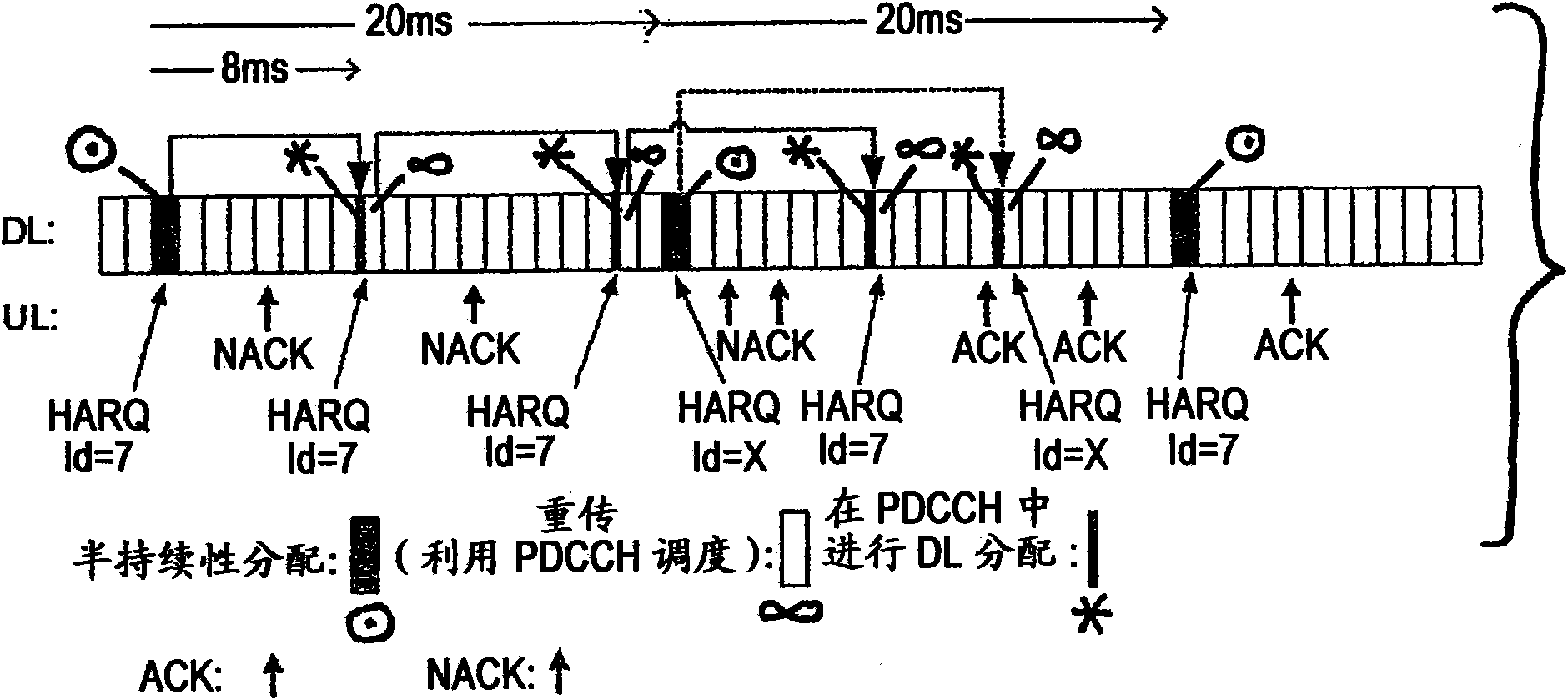Improved re-transmission capability in semi-persistent transmission
A semi-persistent scheduling, hybrid automatic retransmission technology, applied in transmission systems, digital transmission systems, error prevention/detection using return channels, etc., can solve problems such as increasing UE complexity and storage requirements
- Summary
- Abstract
- Description
- Claims
- Application Information
AI Technical Summary
Problems solved by technology
Method used
Image
Examples
Embodiment approach 1
[0089] Embodiment 1A: PDCCH signaling can signal X number of HARQ processes (for example, X=8 using 3 bits). One of the values of X indicates semi-persistent HARQ scheduling. The number of HARQ processes for the semi-persistent case is given by N and this number is signaled via RRC signaling with one HARQ process ID indicating semi-persistent. A HARQ buffer indicating semi-persistent (eg, buffer 7 when X=8) is divided into N sub-buffers (eg, 7, 8, . . . , 7+N-1). Since semi-persistent allocation is more suitable for traffic with small packets, such as VoIP, it is assumed that the size of these sub-buffers is sufficient for semi-persistent traffic. Then for each semi-persistent allocation (for new packets), the subbuffer identification can be implicitly derived from the periodic pattern, the number of TTIs and the number of HARQ buffers reserved for semi-persistent use. One such equation is as follows:
[0090] sub-buffer=[trunc(current_TTI / SP_period)]modNumber_of_semi-per...
Embodiment approach 2
[0095] Embodiment 2A: In the PDCCH, one of X HARQ processes may be signaled (for example, X=8 using 3 bits). One of these X values indicates that the parameters in the PDCCH are used for semi-persistent allocation. The number of HARQ processes used for semi-persistent is N and this value is signaled via RRC signaling with one HARQ process ID indicating semi-persistent eg last HARQ buffer X-1. The HARQ buffer is divided into X+N-1 buffers, which do not need to be of equal size, eg smaller sized buffers may be sufficient for semi-persistent allocation. Then if the PDCCH indicates semi-persistent via the HARQ process ID, or if semi-persistent allocation is in use, the correct HARQ buffer for semi-persistent transmission of new packets can be derived from the following equation:
[0096] HARQ buffer=X-1+[trunc(current_TTI / SP_period)]modNumber_of_semi-persistent_HARQ
[0097] For the retransmission of semi-persistent allocation, several possible signaling schemes are given in t...
Embodiment approach 3
[0098] Embodiment 3A: PDCCH signaling can transmit X HARQ processes. Multiple HARQ processes and HARQ IDs are reserved for semi-persistent. One of them indicates the semi-persistence in the initial allocation to identify that the semi-persistence is in use. All these HARQ IDs form a HARQ process vector Y. The HARQ process used in the case of semi-persistent allocation can be derived, for example, from the following equation:
[0099] vector_index=[trunc(current_TTI / SP_period)]modNumber_of_semi-persistent_HARQ
[0100] HARQ buffer=Y(vector_index)
[0101] For retransmissions of semi-persistent allocations, possible signaling schemes are described with reference to embodiments 1B, 2B, 3B and 4B.
PUM
 Login to View More
Login to View More Abstract
Description
Claims
Application Information
 Login to View More
Login to View More - R&D
- Intellectual Property
- Life Sciences
- Materials
- Tech Scout
- Unparalleled Data Quality
- Higher Quality Content
- 60% Fewer Hallucinations
Browse by: Latest US Patents, China's latest patents, Technical Efficacy Thesaurus, Application Domain, Technology Topic, Popular Technical Reports.
© 2025 PatSnap. All rights reserved.Legal|Privacy policy|Modern Slavery Act Transparency Statement|Sitemap|About US| Contact US: help@patsnap.com



